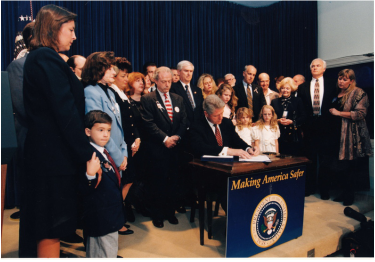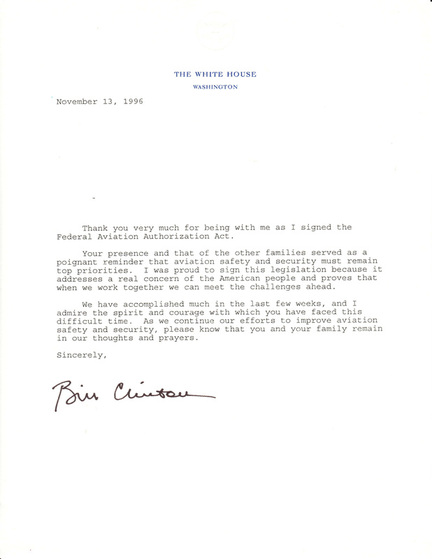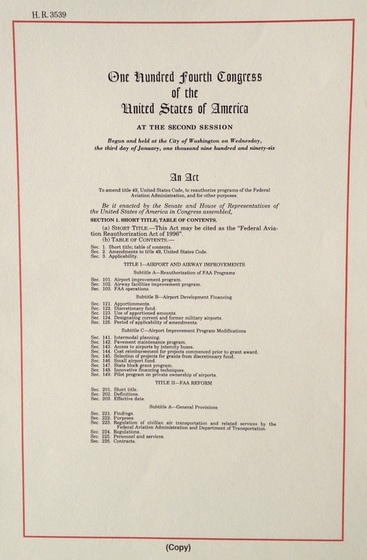Aviation Disaster Family Assistance Act of 1996

The below is a brief summary of experiences shared by many Flight 4184 family members in the aftermath of the accident. It is important to express that these experiences do not diminish the positive interactions some 4184 families had with their CARE team members, nor do they discredit the actions of emergency responders who were attempting to do the right thing following an event which they had never experienced previously.
On November 1, 1994, Flight 4184 families started a journey that began with the shocking mistreatment of their loved ones and their belongings and ended with national legislation. This ensured effective coordination for the support provided to family members following major aviation accidents, known as the Aviation Disaster Family Assistance Act of 1996.
Following the crash of American Eagle Flight 4184, several areas of critical importance to the families were mishandled. The victim identification process fell short. Although 68 caskets containing small amounts of the remains of the each victim were distributed to all families, for most, their loved ones were buried in seventeen caskets of “unidentified remains.” These seventeen caskets were interred at night, without seeking the consent of the families nor informing them of the internment. Additionally, at least one family received remains that were misidentified. Families learned that most of the identifiable personal effects of their loved ones were destroyed rather than being returned to them. The cleanup efforts at the crash site lacked coordination and were incomplete. Families and friends who visited the site months after the clean up was completed retrieved human remains, personal effects, and plane parts.
With their shared experiences, many Flight 4184 families came together to seek explanations for these tragic events. They wrote to their local government officials, as well as their elected representatives in the United States Congress, to make them aware of their experience and to outline a more compassionate and organized response for future aviation disaster victim families.
It was during this time of advocacy that the Flight 4184 families connected with families from the US Air Flight 427 aviation disaster, which occurred on September 8, 1994 in Pittsburgh, Pennsylvania. Both family groups discovered striking similarities in their experiences and concerns. The Flight 427 families also sought to advocate for federal legislation to address the treatment of victims’ families following a commercial aviation disaster. Flight 4184 families joined with those from Flight 427 with the hope of affecting national policy.
On June 20, 1995, family members from Flight 4184 and 427, along with aviation disaster survivors from US Air Flight 5050 and US Air Flight 405 brought their concerns to a meeting hosted by the National Transportation Safety Board (NTSB) and the Department of Transportation (DOT). The goal of the meeting was for the NTSB and DOT to understand the common issues and develop a plan to move forward. The meeting resulted in an outline of 14 points of concern experienced by victims’ families and aviation disaster survivors. Ultimately, a majority of these points would be incorporated into the plan mandated by the Act.
On November 11, 1995, in Pittsburgh, Pennsylvania, a group of family members and survivors from Flight 4184, Northwest Flight 255, Pan Am Flight 103, United Flight 232, US Air Flight 427, US Air Flight 405, and US Air Flight 5050 met to develop an advocacy plan under two newly formed not-for-profit organizations, National Air Disaster Alliance (which served the advocacy effort) and National Air Disaster Foundation (which supported the family | survivor support and education efforts). These organizations created a single alliance--the National Air Disaster Alliance/Foundation. Their immediate goal was to advocate for federal legislation to detail oversight and provide guidelines for the post-accident treatment of victims’ families and survivors.
In 1996, momentum for the cause began to build as families and survivors spoke weekly with congressional staff and government leaders. Many felt an important change was on the horizon. In May, families and survivors were saddened at news of the crash of ValuJet Flight 592 in the Miami, Florida, Everglades, and again in July when TWA Flight 800 crashed off of Long Island, New York. Some families from these accidents quickly joined forces with the 4184 group in addition to the previously listed family groups.
With their mutual experiences and focused advocacy efforts, the families saw quick and nearly unanimous action by the President and the US Congress to address their concerns.
On October 9, 1996, President Clinton signed HR 3539 (104th) the Federal Aviation Administration (FAA) Re-authorization Act of 1996 into law. Included in this under Title VII was Family Assistance - Aviation Disaster Family Assistance Act of 1996.
HR 3923 (104th) – Aviation Disaster Family Assistance Act of 1996
The Act forged a new responsibility for the NTSB to create the Transportation Disaster Assistance (TDA) Division within the agency. The TDA was charged with coordinating the resources of federal, state, and local agencies, transportation carriers, and the American Red Cross, to meet the needs of family members and survivors following a transportation accident. TDA also serves as the primary resource for investigative information for family members and survivors. For more information about the TDA please visit www.ntsb.gov/tda
The families from Flight 4184 are grateful for the positive changes effected by our experience. We have learned that family members impacted by accidents since the passage of legislation have benefited from our advocacy efforts.
We thank the airline industry, the NTSB, and the American Red Cross for their work in upholding the integrity of the legislation.
May our lessons learned never be repeated.
On November 1, 1994, Flight 4184 families started a journey that began with the shocking mistreatment of their loved ones and their belongings and ended with national legislation. This ensured effective coordination for the support provided to family members following major aviation accidents, known as the Aviation Disaster Family Assistance Act of 1996.
Following the crash of American Eagle Flight 4184, several areas of critical importance to the families were mishandled. The victim identification process fell short. Although 68 caskets containing small amounts of the remains of the each victim were distributed to all families, for most, their loved ones were buried in seventeen caskets of “unidentified remains.” These seventeen caskets were interred at night, without seeking the consent of the families nor informing them of the internment. Additionally, at least one family received remains that were misidentified. Families learned that most of the identifiable personal effects of their loved ones were destroyed rather than being returned to them. The cleanup efforts at the crash site lacked coordination and were incomplete. Families and friends who visited the site months after the clean up was completed retrieved human remains, personal effects, and plane parts.
With their shared experiences, many Flight 4184 families came together to seek explanations for these tragic events. They wrote to their local government officials, as well as their elected representatives in the United States Congress, to make them aware of their experience and to outline a more compassionate and organized response for future aviation disaster victim families.
It was during this time of advocacy that the Flight 4184 families connected with families from the US Air Flight 427 aviation disaster, which occurred on September 8, 1994 in Pittsburgh, Pennsylvania. Both family groups discovered striking similarities in their experiences and concerns. The Flight 427 families also sought to advocate for federal legislation to address the treatment of victims’ families following a commercial aviation disaster. Flight 4184 families joined with those from Flight 427 with the hope of affecting national policy.
On June 20, 1995, family members from Flight 4184 and 427, along with aviation disaster survivors from US Air Flight 5050 and US Air Flight 405 brought their concerns to a meeting hosted by the National Transportation Safety Board (NTSB) and the Department of Transportation (DOT). The goal of the meeting was for the NTSB and DOT to understand the common issues and develop a plan to move forward. The meeting resulted in an outline of 14 points of concern experienced by victims’ families and aviation disaster survivors. Ultimately, a majority of these points would be incorporated into the plan mandated by the Act.
On November 11, 1995, in Pittsburgh, Pennsylvania, a group of family members and survivors from Flight 4184, Northwest Flight 255, Pan Am Flight 103, United Flight 232, US Air Flight 427, US Air Flight 405, and US Air Flight 5050 met to develop an advocacy plan under two newly formed not-for-profit organizations, National Air Disaster Alliance (which served the advocacy effort) and National Air Disaster Foundation (which supported the family | survivor support and education efforts). These organizations created a single alliance--the National Air Disaster Alliance/Foundation. Their immediate goal was to advocate for federal legislation to detail oversight and provide guidelines for the post-accident treatment of victims’ families and survivors.
In 1996, momentum for the cause began to build as families and survivors spoke weekly with congressional staff and government leaders. Many felt an important change was on the horizon. In May, families and survivors were saddened at news of the crash of ValuJet Flight 592 in the Miami, Florida, Everglades, and again in July when TWA Flight 800 crashed off of Long Island, New York. Some families from these accidents quickly joined forces with the 4184 group in addition to the previously listed family groups.
With their mutual experiences and focused advocacy efforts, the families saw quick and nearly unanimous action by the President and the US Congress to address their concerns.
On October 9, 1996, President Clinton signed HR 3539 (104th) the Federal Aviation Administration (FAA) Re-authorization Act of 1996 into law. Included in this under Title VII was Family Assistance - Aviation Disaster Family Assistance Act of 1996.
HR 3923 (104th) – Aviation Disaster Family Assistance Act of 1996
- July 31, 1996 – Introduction of the bill
- September 9, 1996 - President Bill Clinton signed an executive order mandating a more compassionate response to victims' families of aviation disasters
- September 18, 1996 - passed the United States House of Representatives
- October 9, 1996 - families and survivors convened at the Old Executive Office Building to witness President Clinton sign HR 3923 into a public law
The Act forged a new responsibility for the NTSB to create the Transportation Disaster Assistance (TDA) Division within the agency. The TDA was charged with coordinating the resources of federal, state, and local agencies, transportation carriers, and the American Red Cross, to meet the needs of family members and survivors following a transportation accident. TDA also serves as the primary resource for investigative information for family members and survivors. For more information about the TDA please visit www.ntsb.gov/tda
The families from Flight 4184 are grateful for the positive changes effected by our experience. We have learned that family members impacted by accidents since the passage of legislation have benefited from our advocacy efforts.
We thank the airline industry, the NTSB, and the American Red Cross for their work in upholding the integrity of the legislation.
May our lessons learned never be repeated.
National Transportation Safety Board
In March 2011, the NTSB hosted a conference entitled “Family Assistance: Promoting an International Approach for the Transportation Industry” in Washington, DC. This conference brought together family members, survivors, representatives from the transportation industry, governmental agencies, and the media to share perspectives on best practices and lessons learned in providing family assistance. Additionally, this conference coincided with the 15-year observance of the Aviation Disaster Family Assistance Act and the 10-year observance of ICAO Circular 285, a guidance document for countries and aircraft operators for establishing family assistance programs. At this conference the NTSB debuted this video highlighting the need for this legislation.
|
|


